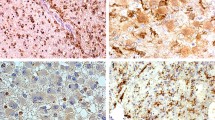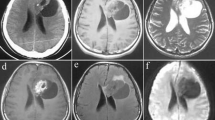Abstract
Clear cell histology is the hallmark of oligodendroglioma (OG) but also characterizes clear cell ependymoma (CCE) and central neurocytoma (CN). Immunohistochemistry for glial and neuronal proteins may support differential diagnosis. We investigated systematically diagnostic value and limits of immunohistochemistry using representative tumor specimens (>1 cm in diameter) of well-defined OGs, CCEs, and CNs (n=10, respectively). Antibodies comprised anti-neuron specific nuclear protein (NEUN), anti-synaptophysin, anti-neuron-specific enolase, anti-microtubule-associated protein 2, anti-phosphorylated neurofilament protein, anti-non-phosphorylated neurofilament protein, anti-glial fibrillary acidic protein (GFAP), anti-S100 protein, anti-vimentin (VIM), and anti-epithelial membrane antigen (EMA). Among the panel of antibodies anti-NEUN, anti-VIM and anti-EMA proved most useful for differential diagnosis. Prominent (>90%) anti-NEUN immunolabeling of tumor cells clearly distinguished CNs from OGs and CCEs. Anti-VIM immunolabeling and a characteristic cytoplasmic dot-like anti-EMA immunoreactivity pattern of tumor cells were detectable only in OGs and CCEs. Furthermore, prominent anti-VIM immunoreactivity and anti-EMA cell membrane staining including ring-like staining pattern is characteristic for CCEs. Additionally, a widespread gliofibrillary and minigemistocytic cytoplasmic anti-GFAP immunostaining pattern is restricted to some OGs. Our data indicate that immunohistochemistry using anti-NEUN, anti-VIM, and anti-EMA on representative tumor specimens allows clear-cut distinction of CNs vs OGs and CCEs. Anti-VIM, anti-EMA, and anti-GFAP support differential diagnosis of OGs vs CCEs. Nevertheless, it is noted that due to focal expression of glial proteins in CNs and, conversely, of neuronal proteins in OGs and CCEs, immunohistochemistry is of limited value on small tumor specimens.

Similar content being viewed by others
References
Ambros PF, Ambros IM (2001) Pathology and biology guidelines for resectable and unresectable neuroblastic tumors and bone marrow examination guidelines. Med Pediatr Oncol 37:492–504
Birner P, Piribauer M, Fischer I, Gatterbauer B, Marosi C, Ambros PF, Ambros IM, Bredel M, Oberhuber G, Rossler K, Budka H, Harris AL, Hainfellner JA (2003) Vascular patterns in glioblastoma influence clinical outcome and associate with variable expression of angiogenic proteins: evidence for distinct angiogenic subtypes. Brain Pathol 13:133–143
Blumcke I, Becker AJ, Normann S, Hans V, Riederer BM, Krajewski S, Wiestler OD, Reifenberger G (2001) Distinct expression pattern of microtubule-associated protein-2 in human oligodendrogliomas and glial precursor cells. J Neuropathol Exp Neurol 60:984–993
Caceres A, Binder LI, Payne MR, Bender P, Rebhun L, Steward O (1984) Differential subcellular localization of tubulin and the microtubule-associated protein MAP2 in brain tissue as revealed by immunocytochemistry with monoclonal hybridoma antibodies. J Neurosci 4:394–410
Clark HB (1984) Immunohistochemistry of nervous system antigens: diagnostic applications in surgical neuropathology. Semin Diagn Pathol 1:309–316
Cooke HJ, Hindley J (1979) Cloning of human satellite III DNA: different components are on different chromosomes. Nucleic Acids Res 6:3177–97
Engelhard H, Stelea A, Cochran E (2002) Oligodendroglioma: pathology and molecular biology. Surg Neurol 58:111–117
Figarella-Branger D, Pellissier JF, Daumas-Duport C, Delisle MB, Pasquier B, Parent M, Gambarelli D, Rougon G, Hassoun J (1992) Central neurocytomas. Critical evaluation of a small-cell neuronal tumor. Am J Surg Pathol 16:97–109
Gelpi E, Ambros IM, Birner P, Luegmayr A, Drlicek M, Fischer I, Kleinert R, Maier H, Huemer M, Gatterbauer B, Anton J, Rossler K, Budka H, Ambros PF, Hainfellner JA (2003) Fluorescent in situ hybridization on isolated tumor cell nuclei: a sensitive method for 1p and 19q deletion analysis in paraffin-embedded oligodendroglial tumor specimens. Mod Pathol 16:708–715
Giangaspero F, Cenacchi G, Losi L, Cerasoli S, Bisceglia M, Burger PC (1997) Extraventricular neoplasms with neurocytoma features. A clinicopathological study of 11 cases. Am J Surg Pathol 21:206–212
Haan EA, Boss BD, Covan WM (1982) Production and characterization of monoclonal antibodies against the “brain-specific” proteins 14–3-2 and S-100. Proc Natl Acad Sci USA 79:7585–7589
Hasselblatt M, Paulus W (2003) Sensitivity and specificity of epithelial membrane antigen staining patterns in ependymomas. Acta Neuropathol (Berl) 106:385–388
Hassoun J, Gambarelli D, Grisoli F, Pellet W, Salamon G, Pellissier JF, Toga M (1982) Central neurocytoma. An electron-microscopic study of two cases. Acta Neuropathol 56:151–156
Herpers MJ, Budka H (1984) Glial fibrillary acidic protein (GFAP) in oligodendroglial tumors: gliofibrillary oligodendroglioma and transitional oligoastrocytoma as subtypes of oligodendroglioma. Acta Neuropathol 64:265–272
Ishiuchi S, Tamura M (1997) Central neurocytoma: an immunohistochemical, ultrastructural and cell culture study. Acta Neuropathol 94:425–435
Jaffe E, Harris N, Stein H, Vardiman J (2001) World Health Organisation classification of tumours: Pathology and genetics of tumours of haematopoietic and lymphoid tissues, 1st edn. IARC Press, Lyon
Kleihues P, Cavenee W (2000) World Health Organisation classification of tumours: pathology and genetics of tumours of the nervous system, 2nd edn. IARC Press, Lyon
Kleihues P, Louis DN, Scheithauer BW, Rorke LB, Reifenberger G, Burger PC, Cavenee WK (2002) The WHO classification of tumors of the nervous system. J Neuropathol Exp Neurol 61:215–225
Lee V, Wu H, Schlaepfer W (1982) Monoclonal antibodies recognize individual neurofilament triplet proteins. Proc Natl Acad Sci USA 79:6089–6092
McLendon R, Bigner D (1994) Immunohistochemistry of the glial fibrillary acidic protein: basic and applied considerations. Brain Pathol 4:221–228
Min KW, Scheithauer BW (1997) Clear cell ependymoma: a mimic of oligodendroglioma: clinicopathologic and ultrastructural considerations. Am J Surg Pathol 21:820–826
Mullen R, Buck C, Smith A (1992) NeuN, a neuronal specific nuclear protein in vertebrates. Development 116:201–211
Parker JR, Armstrong DL, Strother D, Rudman DM, Dauser RC, Laurent JP, Deyd J, Rouah PE (2001) Antineuronal nuclei immunohistochemical staining patterns in childhood ependymomas. J Child Neurol 16:548–552
Perry A (2003) Pathology of low-grade gliomas: an update of emerging concepts. Neuro-oncol 5:168–178
Perry A, Fuller CE, Banerjee R, Brat DJ, Scheithauer BW (2003) Ancillary fish analysis for 1p and 19q status: preliminary observations in 287 gliomas and oligodendroglioma mimics. Front Biosci 8:A1–A9
Perry A, Scheithauer BW, Macaulay RJ, Raffel C, Roth KA, Kros JM (2002) Oligodendrogliomas with neurocytic differentiation. A report of 4 cases with diagnostic and histogenetic implications. J Neuropathol Exp Neurol 61:947–955
Pinkus G, Kurtin P (1985) Epithelial membrane antigen: a diagnostic discriminant in surgical pathology: immunohistochemical profile in epithelial, mesenchymal, and hematopoietic neoplasms using paraffin sections and monoclonal antibodies. Hum Pathol 16:929–940
Royds JA, Ironside JW, Taylor CB, Graham DI, Timperley WR (1986) An immunohistochemical study of glial and neuronal markers in primary neoplasms of the central nervous system. Acta Neuropathol 70:320–326
Smith JS, Alderete B, Minn Y, Borell TJ, Perry A, Mohapatra G, Hosek SM, Kimmel D, O’Fallon J, Yates A, Feuerstein BG, Burger PC, Scheithauer BW, Jenkins RB (1999) Localization of common deletion regions on 1p and 19q in human gliomas and their association with histological subtype. Oncogene 18:4144–4152
ten Berge R, Snijdewint F, Mensdorf-Pouilly S von, Poort-Keesom R, Oudejans J, Meijer J, Willemze R, Hilgers J, Meijer C (2001) MUC1 (EMA) is preferentially expressed by ALK positive anaplastic large cell lymphoma, in the normally glycosylated or only partly hypoglycosylated form. J Clin Pathol 54:933–939
Uematsu Y, Rojas-Corona RR, Llena JF, Hirano A (1989) Distribution of epithelial membrane antigen in normal and neoplastic human ependyma. Acta Neuropathol 78:325–328
Van Eldik LJ, Jensen RA, Ehrenfried BA, Whetsell WO (1986) Immunohistochemical localization of S100 beta in human nervous system tumors by using monoclonal antibodies with specificity for the S100 beta polypeptide. J Histochem Cytochem 34:977–982
Vinores SA, Bonnin JM, Rubinstein LJ, Marangos PJ (1984) Immunohistochemical demonstration of neuron-specific enolase in neoplasms of the CNS and other tissues. Arch Pathol Lab Med 108:536–540
Wharton SB, Chan KK, Hamilton FA, Anderson JR (1998) Expression of neuronal markers in oligodendrogliomas: an immunohistochemical study. Neuropathol Appl Neurobiol 24:302–308
Wiedenmann B, Franke WW, Kuhn C, Moll R, Gould VE (1986) Synaptophysin: a marker protein for neuroendocrine cells and neoplasms. Proc Natl Acad Sci USA 83:3500–3504
Wolf HK, Buslei R, Schmidt-Kastner R, Schmidt-Kastner PK, Pietsch T, Wiestler OD, Blümcke I (1996) NeuN: a useful neuronal marker for diagnostic histopathology. J Histochem Cytochem 44:1167–1171
Acknowledgements
This work was carried out within the Austrian Neuro-Oncology Network (ANN, www.ann.at), supported by the Children’s Cancer Research Institute (CCRI), St. Anna Children’s Hospital Vienna, and by the Scientific Funds of the Mayor of Vienna (project no. 2026).
Author information
Authors and Affiliations
Corresponding author
Rights and permissions
About this article
Cite this article
Koperek, O., Gelpi, E., Birner, P. et al. Value and limits of immunohistochemistry in differential diagnosis of clear cell primary brain tumors. Acta Neuropathol 108, 24–30 (2004). https://doi.org/10.1007/s00401-004-0856-9
Received:
Revised:
Accepted:
Published:
Issue Date:
DOI: https://doi.org/10.1007/s00401-004-0856-9




